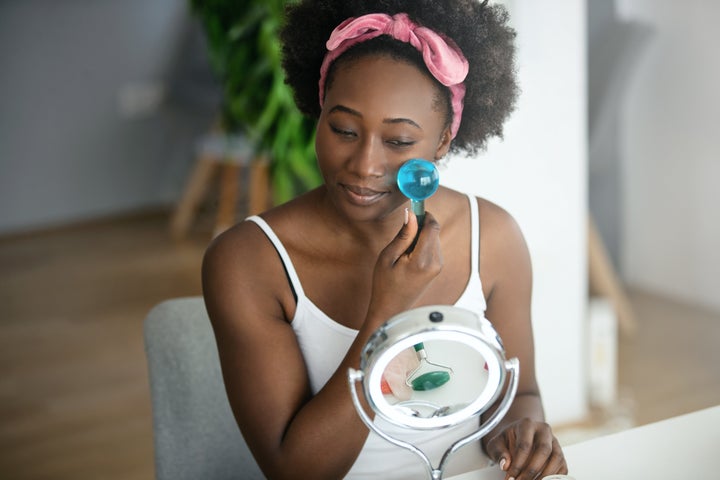
In the opening scene of the 1981 film “Mommie Dearest,” the main character, based on Hollywood legend Joan Crawford, goes through an extensive skin care routine. In the last step of the iconic scene, she buries her face in a bowlful of ice.
Crawford, who was at the height of her fame in the 1930s and ’40s, was reportedly a fan of ice facials to keep her skin looking young and fresh. And somehow, the technique remains a trend today — supermodel Kate Moss is also a fan of the method. On TikTok, videos tagged #icefacial have been viewed more than 600 million times, showing people dunking their faces in sinks full of ice water or gliding ice cubes over their faces.
Dermatologists and skin care experts say an ice facial can have several benefits, including reducing redness and depuffing.
However, these effects are usually “modest at best,” said Dr. Dustin Portela, an osteopathic physician specialising in dermatology based in Boise, Idaho. “For this reason, myself and most dermatologists don’t widely recommend them.”
Still, ice facials are popular because they’re easy and inexpensive to do and generally harmless, said Natalie Aguilar, an aesthetician and dermatological nurse at Kami Parsa Oculoplastic Surgery in Beverly Hills.
Along with the purported skin benefits, she said, “The sensation of cold on the skin can provide a refreshing feeling, contributing to the appeal, especially on a summer day, or for women experiencing peri- or postmenopausal symptoms or hormonal fluctuations.”
Here’s an overview of some of the benefits of ice facials, a few downsides, and what you should know about doing them, according to experts.
What is an ice facial?
Simply put, an ice facial refers to applying ice to your face, whether it’s submerging your face into ice water, or using an ice globe massage tool, ice face mask or ice roller.
“The key is the application of cold to the skin and using tools that one enjoys and that are easy to use which will allow for consistency,” Aguilar said.
The benefits of ice facials.
Ice facials can make your skin look tighter and more hydrated, reduce redness and temporarily shrink pores, said Chris Bustamante, an aesthetic nurse practitioner and founder of Lushful Aesthetics in New York.
The cold causes vasoconstriction, or narrowing of the blood vessels, Bustamante said. “By reducing that superficial blood flow to the face, redness is reduced and pores look minimised.”
But in most cases, the skin improvements from ice facials only last for a few hours, said Bustamante, who recommended seeing a dermatologist or aesthetician for longer-lasting treatments to address your skin concerns.

Here’s what’s happening in that brief period of time: The constricting blood vessels can reduce inflammation and give your skin a “brighter and more radiant overall” appearance, according to the Cleveland Clinic. Coldness also helps drain extra fluid built up in your lymphatic system, which can reduce puffiness on your face and under your eyes. Ice can also help reduce inflammation, Aguilar said.
But there’s little scientific research showing that ice facials can offer long-term benefits, Portela said. “Any perceived benefit is likely individual and temporary.”
Are there any downsides to an ice facial?
Exposure to the cold can be uncomfortable for some. Otherwise, ice facials are generally safe for most people, Bustamante said. Just limit the cold exposure to 15 minutes or less ― any more won’t offer extra benefits and could actually damage the skin in a number of ways.
The most common issue is that people who are sensitive to the cold could experience redness when using an ice facial, Portela said. It could also trigger a redness flare for people with rosacea. And touching the ice with their fingers could trigger symptoms for people with chilblains, a condition that causes swelling and blistering on the hands or feet when exposed to the cold, or Raynaud’s syndrome, a disorder causing blood vessel spasms in your fingers, lips or nose, as a response to coldness.
People with autoimmune disorders, diabetes, peripheral neuropathy or cardiovascular conditions should check with their doctors before trying an ice facial, as they may be especially sensitive to a reduced body temperature or impaired circulation, Aguilar said.
If you expose your skin to ice for too long, such as more than 15 minutes, it could put you at risk for ice burns or frostbite. According to the Cleveland Clinic, this could cause pain, numbness, swelling or discolouration.
If you have sensitive skin, it might be best to avoid an ice facial, the Cleveland Clinic also noted. If you have broken capillaries or are recovering from a cosmetic procedure, like laser treatment or surgery, let your skin heal naturally first.
How to do an ice facial.
It’s safe to do an ice facial a few times a week, as long as you limit them to 15 minutes max, Aguilar said.
There’s no right or wrong way to do an ice facial (with the exception of the amount of time your face is exposed to cold conditions). Bustamante said you can submerge your face in a bowl of ice water, use an ice globe or mask, or try an ice roller. Some people might not want to apply ice directly to the skin and can wrap it in a cloth to create a barrier.
It’s also a good idea to wash your face before icing to remove any makeup or skin care products, according to Bustamante. “There’s really no way of messing it up as long as everything is clean,” he said.
Always clean reusable products after you use them, Portela said. He recommended also using filtered or distilled water to ensure the ice is free from bacteria.
Follow up your ice facial with a moisturiser with humectants, such as glycerin or snail mucin-based products, to “lock in moisture so your skin doesn’t dry out,” Bustamante said.
“It’s important to listen to your skin, and if one experiences discomfort or negative reactions discontinue application immediately,” she said.